June is LGBT Pride Month, so we’re celebrating all of our pride by feeding babies to lions! Just kidding, we’re talking about lesbian history, loosely defined as anything that happened in the 20th century or earlier, ’cause shit changes fast in these parts. We’re calling it The Way We Were, and we think you’re gonna like it. For a full index of all “The Way We Were” posts, click that graphic to the right there.
1. Call For Submissions, by The Editors
2. Portraits of Lesbian Writers, 1987-1989, by Riese
3. The Way We Were Spotlight: Vita Sackville-West, by Sawyer
4. The Unaccountable Life of Charlie Brown, by Jemima
5. Read a F*cking Book: “Odd Girls & Twilight Lovers: A History of Lesbian Life in 20th-Century America”, by Riese
6. Before “The L Word,” There Was Lesbian Pulp Fiction, by Brittani
7. 20 Lesbian Slang Terms You’ve Never Heard Before, by Riese
8. Grrls Grrls Grrls: What I Learned From Riot, by Katrina
![]()
I wasn’t there when it happened. Not by choice, just by circumstance.
In 1991, when the riot grrrl scene was growing in the Pacific Northwest and Washington, DC, I was one year old. I was taking my clothes off and screaming and breaking things, but that was probably just a coincidence. And even though I wouldn’t learn what riot meant for another 16 years, what was happening then would inevitably shape the feminist consciousness that I would grow to inherit.
My generation is the one that knows Kathleen Hanna from Le Tigre. Our friends who don’t run in feminist circles know Carrie Brownstein from Portlandia. And for those of us who do know who Brownstein was in relation to the movement, the only way we could have ever seen her gloriously kick and cartwheel across a stage was not with Sleater-Kinney, but with riot supergroup Wild Flag.
These are the heirlooms of riot. They’re what our foresisters left for us to make sure we would never forget.
We may not have experienced it firsthand, but there is a story that is told to us as young feminists, artists, organizers and – yes – rebel girls. It’s like a punk rock bedtime story to know by heart, sort of like a tweaked-out lullaby set to the tune of a thousand wailing guitars.
Here’s how I understand it:
It wasn’t that riot grrrl was born out of punk. It was more like riot set punk on fire and rose screaming out of its ashes. Riot wasn’t about punk like feminism isn’t about men. It didn’t happen because we hated men, it happened because we loved ourselves and knew the kind of world we deserved. What riot wanted couldn’t be contained. And that was the point, wasn’t it? That women and grrrls didn’t have to accept a world built by men. Women didn’t have to adhere to men’s standards of beauty or power or worth. We didn’t have to have conversations using their vocabulary.
In 2010, Sara Marcus published Girls to the Front: The True Story of the Riot Grrrl Revolution, a thoroughly-researched analytical memoir of the riot movement. Marcus explains the grrrls’ outrage:
“The girls were furious about things like parental-consent abortion laws, bikini-clad women who hawked beer and cigarettes on billboards and TV, and the archaic gender roles that pervaded the cartoon section of the Washington Post. They were ready to revolt over things like hallway gropes and sidewalk heckles, leering teachers, homophobic threats, rape, incest, domestic violence, sexual double standards, ubiquitous warnings against walking certain places or dressing certain ways … The affronts were neverending. The girls couldn’t block these things out and they didn’t want to; they wanted to stay acutely aware of the war against them so they could fight back.”
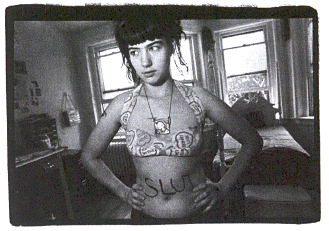 The grrrls were coming to realize the extent to which violence pervaded culture. They knew that violence wasn’t necessarily rape or abuse (though it certainly was that, too); it was also something much more quiet and insidious than that. Violence was a systematic force that worked within our society to tell us, as Kathleen Hanna put it in her Riot Grrrl Manifesto, that “Girl = Dumb, Girl = Bad, Girl = Weak.”
The grrrls were coming to realize the extent to which violence pervaded culture. They knew that violence wasn’t necessarily rape or abuse (though it certainly was that, too); it was also something much more quiet and insidious than that. Violence was a systematic force that worked within our society to tell us, as Kathleen Hanna put it in her Riot Grrrl Manifesto, that “Girl = Dumb, Girl = Bad, Girl = Weak.”
Marcus’s book received overwhelmingly positive reviews from both mainstream media as well as the women who were involved in the founding of riot. This was a particularly huge accomplishment, as riot was decidedly averse to mainstream media, making it practically a policy to refuse interviews for fear of misrepresentation. But this policy came at a price, because there’s something that happens when you don’t let the mainstream media represent (or misrepresent) you: people either make their own judgments based off stereotypes and hearsay, or they forget you exist. Facing the issue of erasure, the riot grrrls created their own narrative, writing their history through art, music, documentaries and zines that honored the work they were doing using their own words and their own voices.
Riot was a way for women to politicize themselves while remaining creative and badass. Creation in itself was a form of resistance and a validation of their existence. They weren’t asking for permission or respect. They didn’t need to ask. That was also the point: not needing anyone’s fucking permission.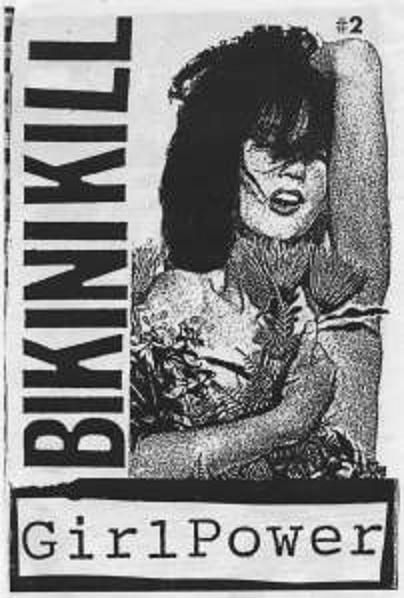
When we live our lives bending to patriarchy – intentionally or not – we do this thing where we sit around waiting for someone to tell us it’s okay. Riot said we didn’t have to. It was a coming-of-age where women who were making music could stand next to each other on a stage without fearing a comparison or a pigeonhole. Standing alongside each other wasn’t a threat, it was an honor, and it was solidarity in an unprecedented manner.
Riot showed us what revolution could look like. We had a new concept of what power could be. We could find it within ourselves and in each other — and we didn’t have to ask. Power lay in our ability to create and in our refusal to be silenced or ashamed or sorry. We could use this to build communities, validate ourselves, have our own voices and see ourselves reflected in the world we wanted to live in, the world we wanted to create.
For grrrls in my generation, riot is literally a history. Two years ago, the papers of Kathleen Hanna were added to the Riot Grrrl archive at the Fales Library at NYU. The university’s newsletter covered the decision, explaining that “the Riot Grrrl Collection will support scholarship in feminism, punk activism, queer theory, music history and more.”
We didn’t see the riot, but we saw the aftermath. We came to the point where we could view it with a critical eye, and we’re coming to understand the ways that race and class play into our activism today. And that’s our responsibility, isn’t it? To hold each other accountable, to respect what came before us, and to keep the legacy strong in the best way that we can.
So without further adieu:
Rebel Girl – Bikini Kill
Crying Shame – 7 Year Bitch
I Like Fucking – Bikini Kill
Shove – L7
Brat Girl – Bratmobile
Ladybug Superfly – Slant 6
Vintage Piranha – The Bangs
Uncle Phranc – Team Dresch
Off With Your Head – Sleater-Kinney
Bruise Violet – Babes in Toyland
Terrorist – Heavens to Betsy
Smells Like Teen Spirit (cover) – Kathleen Hanna
Stream the playlist on 8Tracks!
Get it, grrrls.


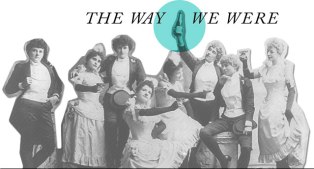
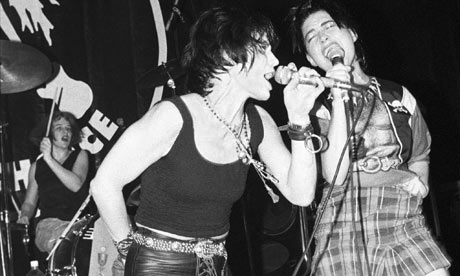
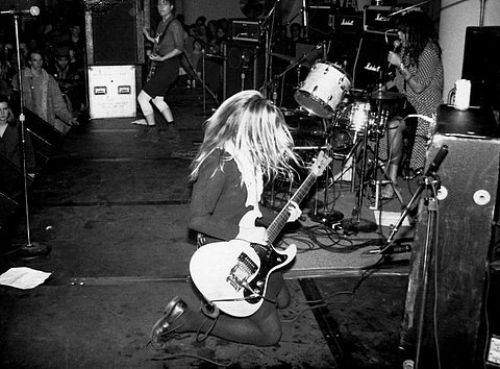

Exactly since this is LGBTQ Pride Month, I want to offer up the following link as a more complete view of Kathleen Hanna… the good, the creative and the not-so-good-at-all: http://crabigailadams.wordpress.com/2010/02/27/on-relating-to-kathleen-hanna/
Thanks for posting this link. I, like Katrina, was too young to live riot, but Kathleen Hanna is one of my feminist idols. It was eye-opening to read this blog post. I wonder if Hanna has read this (or similar posts), and I wonder what she thinks now. Would love to hear a 2012 response from her.
Now when I talk about riot with other ladies my age, we all seem to agree that it’s something that’s 1) close to our hearts 2) an imperfect, but good start. You know? Like, where would I be without riot? It’s an important part of my personal feminist history, and it’s important to acknowledge the flaws (they’re so much more obvious now, which I guess is a sign of progress).
Oh, she totally knows about it… I think she would just as soon it would disappear. In 2010, she “sort of kind of” half-apologized for a very transphobic essay she had written in the past (the stuff she wrote was specifically about trans women, not trans men), but has vaguely characterized it as her own “horizontal oppression” rather than really apologizing and being specific about her actions and who they were against. Again, an important creative artist and gen x feminist but not really a friend to the trans community no matter what JD looks like.
You’re really making me reconsider my Hanna idol worship. Thanks for calling it what it is: “Again, an important creative artist and gen x feminist but not really a friend to the trans community no matter what JD looks like.”
Autostraddle commenters are the best! (Well, most of the time… :)
i’m glad someone brought this up. as a fan of bikini kill, le tigre and just kathleen hanna in general, it’s been hard to reconcile these actions and statements with all the positive effects her voice and her presence has had. as a fan, i don’t feel like it’s my job to defend her. as a queer and a feminist, i do feel like it is my job to move forward and regard her critically while also searching for spaces and figures that are more widely and consciously anti-oppressive. i don’t think these identities have to be mutually exclusive.
“an important creative artist and gen x feminist but not really a friend to the trans community.” i think that’s pretty accurate.
Absolutely… no one has to defend her except Kathleen, herself, if she feels like it. I included that link to inform people about a part of her history they really should know about, just as they should listen to her music and lyrics and see how they feel about that. It is important to point out that Mr. Lady records did absorb a certain amount of updated second wave feminist thought and assumptions (which isn’t too surprising) including much which smelled of transmisogyny. Hopefully, all of our hero warship contains an aspect of meta critical-evaluation in it to temper our love for their work.
Oh, Casino. I love you.
<3 miss you
i love this!
So I came across this link several years ago, but I think it might be of interest to some of you. It has out of print queercore and riot grrl recordings that you can download.
http://stacykonkiel.com/soulponies/
<3
Loved seeing Babes In Toyland on here!
I feel so much yearning for a time that never was with the whole riot grrrl thing
me too =( that’s part of why I was so happy when wild flag became a thing, because I was too young to ever get to see s-k
thisthisthisthisthis. sometimes i feel like i missed the boat on riot grrrl, only finding out about it a few years after it’d kind of petered out. but then, i think, there are still these amazing women around me making music and art and tumblrs and whatever that are carrying forward the beautiful, good parts of this legacy we are left with, and doing it in a way that is still building and growing. i often get nostalgic for things i couldn’t have been a part of but then i remember – i am living in a time that others will feel nostalgic for too, and that’s pretty exciting in and of itself. it inspires me to keep creating, to know that i am part of this feminist continuum, and that we are always doin’ it better. or trying to!
yo, THIS.
Wonderful piece! There are times when I’m obsessed with Sleater-kinney. Carrie Brownstien is one of my biggest influences on guitar. The first song I ever learned to play was “A Quarter to Three”. I still run through it occasionally to get my picking hand awake.
Carrie BrownSTEIN. I hate typos.
CB is one of my biggest influences in LIFE. seeing her AND mary timony perform with wild flag kinda made my life.
Oh, man L7’s Jennifer Finch is a GODDESS.
Born in Portland and having lived in Olympia for years, these ladies and their ideals were a prevalent force in my troublemaking/hellraising/growingup days. Love it.
Checking out ‘Cinderella’s Big Score: Women of the Punk and Indie Underground’ by Maria Raha is worth it for sure.
I love this post so much! Also I just saw Gossip in NYC and during their song 8th wonder Beth started singing Rebel Grrl & my head exploded (on the tube http://youtu.be/-ANImFEx4FY?t=2m )
I WOULD HAVE CRIED.
that being said, beth ditto once fell on me while crowd surfing (i am very short, and therefore a pothole in concert crowds), and it was the best concertgoing experience of my whole fucking life.
this post was fucking excellent. i don’t have a lot else to say.
“i believe in the radical possibilities of pleasure babe, i do i do i do”
http://colorlines.com/archives/2012/05/will_smith_is_a_riot_grrrl.html
I guess it’s not really riot grrl but I wish there was something about Helium around here. Mary Timony’s lyrics on the Pirate Prude EP were kind of huge in making my attitude toward gender what it is today.
Pingback: This was originally just a Sleater-Kinney playlist « The Noticle
I own that Bikini Kill zine and also Girls to the Front and I have never felt cooler.
Pingback: Grrrls! Grrrls! Grrrls!: What I Learned From Riot | girlDick journalism
I know this a really old post but could Jack Off Jill be considered Riot Grrl? I mean, they do call their music “Riot Goth” (even have their tote bag that says that). Just a thought! <3
Pingback: When After School Specials Made Gay People Seem Not-So-Special – www.autostraddle.com - Shortlinker